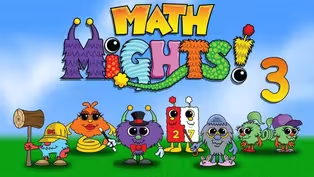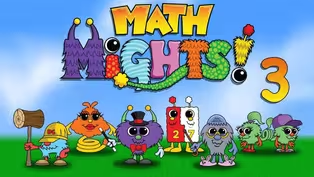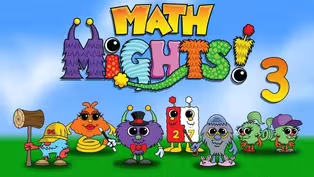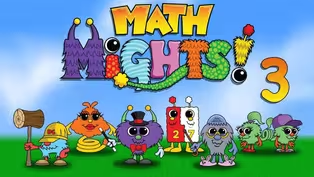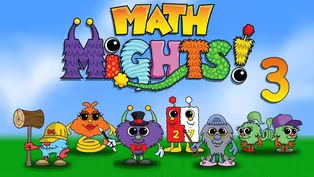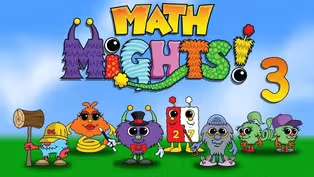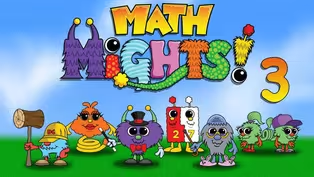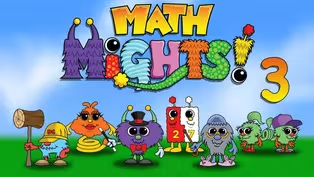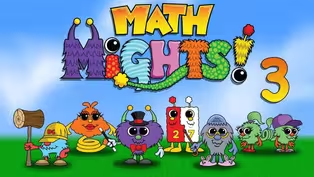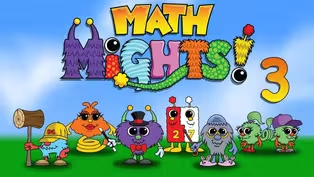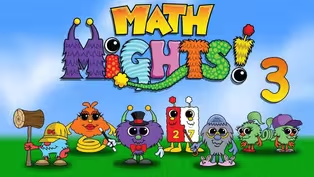Math Mights
Representing Division Part 2
Season 3 Episode 305 | 15m 59sVideo has Closed Captions
Join Ms. Askew and Professor Barble to do a visual model with a word problem.
Join Ms. Askew and Professor Barble to do a visual model with a word problem. Next watch out for Springling as she is going to help us understanding how to use the straegy of multiplying-up to divide.
Problems playing video? | Closed Captioning Feedback
Problems playing video? | Closed Captioning Feedback
Math Mights is a local public television program presented by Detroit PBS
Math Mights
Representing Division Part 2
Season 3 Episode 305 | 15m 59sVideo has Closed Captions
Join Ms. Askew and Professor Barble to do a visual model with a word problem. Next watch out for Springling as she is going to help us understanding how to use the straegy of multiplying-up to divide.
Problems playing video? | Closed Captioning Feedback
How to Watch Math Mights
Math Mights is available to stream on pbs.org and the free PBS App, available on iPhone, Apple TV, Android TV, Android smartphones, Amazon Fire TV, Amazon Fire Tablet, Roku, Samsung Smart TV, and Vizio.
Providing Support for PBS.org
Learn Moreabout PBS online sponsorshipMore from This Collection
Video has Closed Captions
Join Ms. Askew for a tricky multi-step word problem with Professor Barble! (15m 59s)
Build Fraction from Unit Fractions
Video has Closed Captions
Join Ms. Askew for another multi-step word problem with Professor Barble! (15m 59s)
Video has Closed Captions
Join Ms. Askew for a division word problem with her friend Professor Barble. (15m 59s)
Video has Closed Captions
Join Ms. Askew for a division word problem with her friend Professor Barble. (16m)
Dividing with even larger numbers
Video has Closed Captions
Join Ms. Askew and Professor Barble to do a visual model with multiplication. (15m 59s)
Video has Closed Captions
Join Ms. Askew and Professor Barble to see if you can match visual models to word problems (15m 59s)
Dividing with Larger Quotients
Video has Closed Captions
Join Ms. Askew and Professor Barble to see if you can match visual models to word problems (15m 59s)
Video has Closed Captions
Learn about multiplying one-digit whole numbers by multiples of 10. (15m 59s)
Video has Closed Captions
Learn about multiplying numbers larger than 20. (16m)
Video has Closed Captions
Join Mrs. Askew for a Number Talk with 2 Math Might Friends! (16m)
Multiply Teen Numbers with Larger Groups
Video has Closed Captions
Join Mrs. Askew for a Number talk with 2 Math Might Friends! (15m 59s)
Relating Multiplication and Division
Video has Closed Captions
Join Ms. Askew for a subtraction number talk with Springling! (16m)
Providing Support for PBS.org
Learn Moreabout PBS online sponsorship(upbeat music) [Students] Math might.
- Welcome third grade math might friends.
I'm so happy to see that you joined us today.
My name is Ms. Askew and I can't wait to have fun learning about math with you but first let's take a look at our plan for today.
Today, we're gonna do a word problem with our friend Professor Barble, after that we're gonna learn how to multiply-up to divide, let's warm up our brains with Professor Barble as we conquer word problems with visual models.
Professor Barble is a math might friend that lives in Marysville.
He likes to travel and go hiking around Marysville looking for word problems to solve.
He knows that we like to rush in and find the answer but Professor Barble likes to slow us down by following a step-by-step process that helps us to think through what the story problem is asking us.
He likes to wear a thinking cap so that we can create a visual model to help us solve the problem.
Now you might be asking yourself just what is a visual model?
Well, let me tell you a visual model is sometimes known as a model drawing, unit bar, tape diagram or bar model.
A visual model is a reading comprehension strategy for word problems.
Drawing a visual model helps to visualize the strategies and understand what the word problem is asking, Abdul and Patrick have a word problem that they wanna see if they can conquer using a visual model.
There were five crates of milk and each crate, there were nine milk cartons.
How many milk cartons were there in all?
Well, Abdul thinks we should multiply.
Wait, or do we divide as Patrick, if Professor Barble heard them, he would say, they're already moving on to step six where they're trying to solve the problem but we need to slow down.
We have to figure out what the problem is asking us, so we don't have to guess what operation to use whether to add, subtract, multiply or divide.
These seven steps will help you as a third grader to have a better understanding of what a word problem is asking.
Let's take a look at step one.
First, you're gonna read the entire problem and put it into chunks.
I'm gonna read the story problem first and after I would like for you to read it as we put the chunks in.
Let's start, there were five crates of milk and each crate, there were nine milk cartons.
How many milk cartons were there in all?
Now it's your turn, let's read it again and fill in the chunks.
There were five crates of milk, chunk.
And each crate, there were nine milk cartons, chunk.
How many milk cartons were there in all?
Chunk.
The reason why we chunk that story problem is because when we take small sections, we can better understand what the story problem is asking us to do.
Step two, we need to rewrite the question in sentence form with a blank space for the answer.
There were blank milk cartons in all.
By writing the question in sentence form, it helps us to remember what it is we're trying to solve.
Now, it's time for us to call on professor Barble so we can put on our thinking caps and draw a visual model to solve the problem.
In step three, we're going to determine the who and or the what that's involved in the problem.
We look at our starting line, the what in the problem is the milk cartons.
In step four, we're going to draw a unit bar.
This unit bar represents the milk cartons.
Step five, we're going to go back and check when each part is added into the adjusted unit bars and put a question mark at the end, let's read our story problem again and see if we can add the information to our visual model.
First, we know that there were five milk crates so I'm going to divide my unit bar into five sections.
I need to draw four lines because there are five sections.
Don't forget to label what that unit bar represents.
This represents the crates.
Now, I'm going to go back to the story problem and check off my chunk.
The next sentence reads, in each crate there was nine milk cartons.
Looking at my unit bar, I'm going to put nine milk cartons in each of those sections.
Let's go back to our story problem and check off that chunk.
Finally, the question, how many milk cartons were there in all?
We have to label the unknown on our visual model, so we're gonna put a question mark at the end because that's what we're trying to figure out, how many milk cartons were there in all?
let's go back to our story problem and check off that chunk.
As you can see, we have three checks for the three chunks of information in our story problem.
Step six is to correctly compute and solve the problem.
Patrick sees now that we need to multiply and not divide.
Now we can write our equation on the white board, five groups of nine equals 45.
Finally, step seven, we are going to write the answer in the sentence and make sure the answer makes sense.
There were 45 milk cartons in in all, five groups of nine equals 45, excellent work using visual models to slow yourself down when solving story problems.
Now, let's look at our I can statement for today.
I can divide using the multiplying-up strategy.
How can we find the quotient to this problem?
52 divided by four.
Kiran and Mai use multiplication to find the quotient.
What are your thoughts on how they solved it?
Abdul thinks they use multiplying-up to divide.
I wonder if Abdul is right, let's act it out and see what Kiran and Mai did.
Let's use the whiteboard to take a closer look at what they were thinking.
We have the problem 52 divided by four, it looks like they were using the strategy to multiply up.
We're trying to figure out how many groups of four are in 52 and 10 is a friendly number, so they chose to do 10 groups of four equals 40.
Now, if you're anything like me, I like to visualize a problem because multiplying-up can be a difficult strategy to understand.
So I'm going to take my total which is 52 and I'm going to subtract out the 40.
Now, I can see that there's 12 left.
How many groups of four are in 12 three groups of four equals 12.
So I can take out the 12 until there's nothing left.
So 52 divided by four equals 13 because we have 13 groups of four and 52.
Looking at my place value blocks, I can see how this is related to our multiplying-up strategy.
They have 10 groups of four which is 40 and we also have 40.
Then they have three groups of four which is 12 and we have our 12 here, so that equals a total of 52.
Down at the bottom, we see that they have solved it using the area model method.
We're trying to find out how many groups of four are in 52, so we decompose the number 52 into 40 and 12.
There are 10 groups of four and 40 and there are three groups of four and 12.
Well, third grade math mights, I don't know about you but I think this multiplying-up strategy is so cool, it is helping us learn how to solve even harder problems.
Let's not stop now, let's try another one.
48 divided by 3.
When we look at the problem, 48 divided by 3, we're trying to think of how many groups of three are in 48.
Now remember our friends Sringling likes to count on and she also can do that using division.
We use that strategy and it's called multiplying-up.
The target number is 48, the question is how many groups of three are in 48?
Let's act it out, we have this represented with our place value disk.
Our total or our dividend is 48.
We're trying to figure out how many groups of three are in 48.
Well, if we think about that, how many groups of three can we subtract out from 48?
We can think of the friendly number 10 because we know that 10 groups of three equals 30, so let's take away 30.
Now I can visually see that we have 18 left, thinking about those friendly numbers again, how many groups of three will equal the 18 that's left?
I know it's six, six groups of three equals 18, so if we take the 18 away, we have none left.
Now how many groups of three are in 48?
Let's add up to find out.
10 plus six equals 16, so 48 divided by 3 equals 16.
Third grade math might, I am having such a great time using this multiplying-up strategy to do division problems, let's not stop here.
Let's try and practice so we can get really good at it by solving another problem, let's take a look at it.
Let's use the multiplying-up strategy to solve this problem.
91 divided by seven, we're trying to figure out how many groups of seven are in 91.
Let's act it out.
We have a visual representation of that number using our place value disk.
We have the total or the dividend which is 91.
Now, we're trying to figure out how many groups of seven can we subtract out from 91?
Let's think of a friendly number, it's the number 10.
10 groups of seven equals 70, so let's take away 70.
Now I can visually see that there's 21 left, how many groups of seven equals 21?
I know it's three, three groups of seven equals 21.
If I subtract out the 21, there's none left.
Now I wanna know how many groups of seven did we have total.
I take 10 plus three that equals 13.
91 divided by seven equals 13.
Third grade math mights, you are doing an awesome job with multiplying-up, you're doing such a great job that I think we can do an even harder problem with a higher divisor.
Let's see if we can solve with harder numbers.
75 divided by 15.
Looking at our problems 75 divided by 15, we see that the target number is 75.
What we're trying to figure out is how many groups of 15 are in 75.
Let's go back to the whiteboard and act it out so we can have a better understanding.
How many groups of 15 are in 75?
I'm thinking about a friendly multiplication fact that would get me close to the number 75.
I know two groups of 15 because two groups of 15 equals 30.
Now I'm going to subtract out the 30 from the total 75.
I see with my remaining place value disk that I have 45 left, so I'm gonna subtract out another two groups of 15 which is 30.
Looking at my disk, I see that there are 15 left.
Oh, that's easy.
There's one group of 15 in 15 and I will take those out and there are none left.
How many groups of 15 that will make two plus two plus one equals five.
So 75 divided by 15 equals 5.
Third grade math mights, give yourselves a round of applause, you have been working so hard today to solve the vision problems using the multiplying-up strategy, it's really hard at first but as you can see, the more we practice the better we understand it and I don't know about you but those place value disc should come in handy.
Now is your turn to see if you can use the multiplying-up strategy to divide with Springling, you'll be using that strategy to solve four division problems, good luck.
Boys and girls, we had so much fun today, we were hanging out with Professor Barble as he taught us how to slow down when we are thinking about how to solve story problems and we also learned how to use the multiplying-up strategy so that we can solve harder division problems.
You rocked it third grade, I'll see you next time.
(upbeat music) (upbeat music) - [Narrator] sisfourteachers.org.
Changing the way you think about math.
(upbeat music) - [Narrator] This program is made possible with funding from the Michigan department of education.
Governor's Education Emergency Funds, the state of Michigan and by viewers like you.
(upbeat music)


- Home and How To

Hit the road in a classic car for a tour through Great Britain with two antiques experts.










Careers that Work

Support for PBS provided by:
Math Mights is a local public television program presented by Detroit PBS
